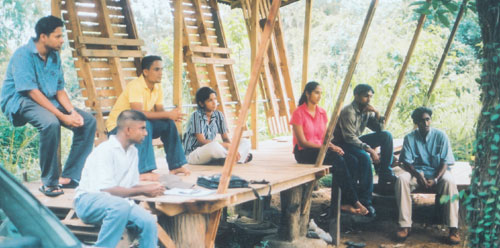| Plus |
|
||||
|
Creativity
takes form in Moratuwa University’s new design course Sri Lanka can only ape the west. Lankans are masters at copying others' work but cannot produce originals. A poor record and scathing criticism for a country which has had a vibrant history going back many thousand years with monuments such as Sigiriya still standing as testimony to its expertise in art and architecture. This seems about to change, with around 100 young men and women coming together from diverse backgrounds and also areas -- such as Galgamuwa, Colombo, Warakapola, Ratnapura, Kirindiwela and Ganemulla to mention a few -- to take up the challenge of bringing about a Sri Lankan identity in simple things, like a piece of jewellery, a humble pot, a wearable garment or a sleek furniture set. These youth
in their early twenties, driven by patriotic fervour, are undergraduates
of the first-ever four-year Bachelor of Design honours degree course
launched in 1999 by the Faculty of Architecture of the University
of Moratuwa. The specialities of the course are ceramics, furniture,
jewellery, graphic design and communication art and fashion and
textiles. Four batches comprising about 100 are in campus at present. But the vision
of this group, the first batch of whom will pass out this year,
is to fill a major lacuna the country is facing - the lack of qualified
designers who will use the vast wealth of resources in the country
to create utility articles of beauty. The role they will play is different "Our designs are meant to meet a need, with problem-solving being one target," says Prabath Jayaratne, 23. In unison they cite the example of the oft seen and oft used pot of curd. "Those days people ate the curd and threw the pot away because no one could use it. Now there is a difference. A suggestion had been made by the students that the shape of the pot should be changed. "This has increased the utility value of the pot because it can be reused for other things." But they hasten
to add that they are not craftsmen, only designers. On campus they
go to the finish, till the final product comes out to prove that
what they have drawn on paper can really be made. They lament the
lack of qualified designers. "Lankawe loku aduwak thiyenawa,"
says Prageeth giving the example of their course itself, where they
sometimes have to get foreigners to come teach the students. Currently
they have three from Japan handling ceramics, jewellery and furniture.
"Most people in Sri Lanka work through experience but few have
qualified in these fields," says Prageeth. "We have
a civilization with a design background, but we do not have proper
designs now. Those in the west take our designs, reproduce our stuff
and sell it back to us." For any design there are two inspirations, explains Prof. de Silva. "The first is Mother Nature with all her colour, composition, form and structure. The other is culture and tradition, which is the accumulated wisdom of the past. We must evolve modern things using tradition." It is also not just another university course. Here they go back to the roots and study the history of whatever product they hope to design. Recently the students were told to design a kite. First they researched and studied the aerodynamics of the Dandu Monara - its form, shape and flying capacity. How did it float and fly? "This
is how tradition can create and influence modernity," says
this dynamic Prof. About the textile industry, he says, "Foreigners
bring equipment, raw material and designs. We produce the garments
but they fix the price, market the garments and garner the profits.
We are given a little. The long-term gain for Sri Lanka is nil." Furniture design
students will study the cane industry. Cane furniture is very expensive.
"We need to design something for the common man which is elegant
and at the same time affordable," he says. Under ceramics,
they will investigate why and how the pottery industry has waned.
In 1975, 60,000 families were living on pottery now not even 3,000.
"Maybe they did not change with the times," he says. For the students the design degree course has opened up new vistas, freedom to try out their ideas and give their imagination free rein. "We are not trapped. We are studying but not just poring over books all the time," says Sumanthri, while the others nod vigorously explaining that they have gone on many trips to view nature and to remote hamlets such as Laaliambe (famous for ancient jewellery) and Pallehapuwide (lacquer) on the trail of tradition. They have also been to India to see how design is handled across the Palk Straits. Right now these pioneer design students are readying themselves to take on the world and stamp a much-needed Sri Lankan identity. |
|||||
Copyright © 2001 Wijeya Newspapers Ltd. All rights reserved. |
|||||
